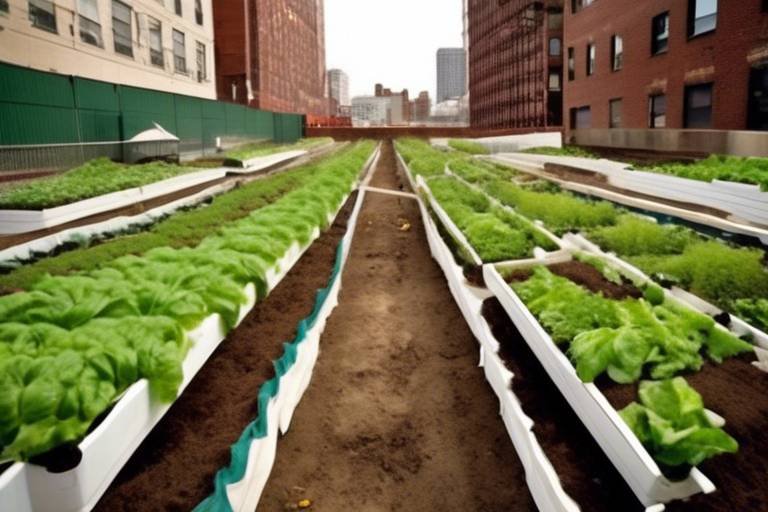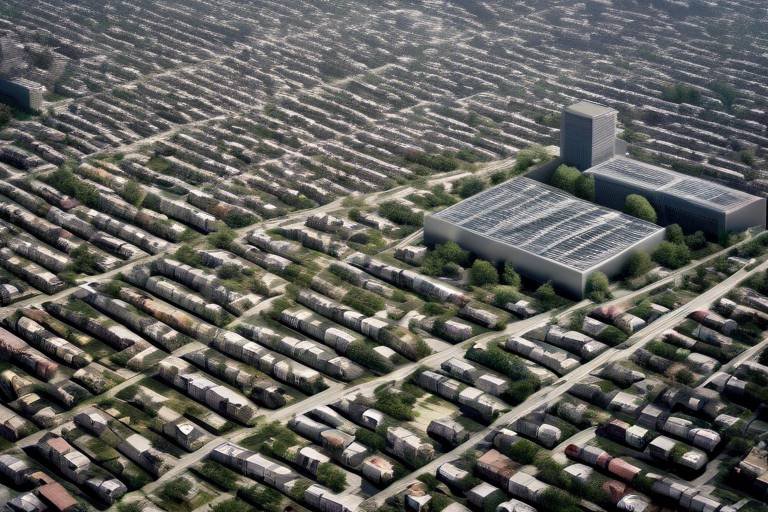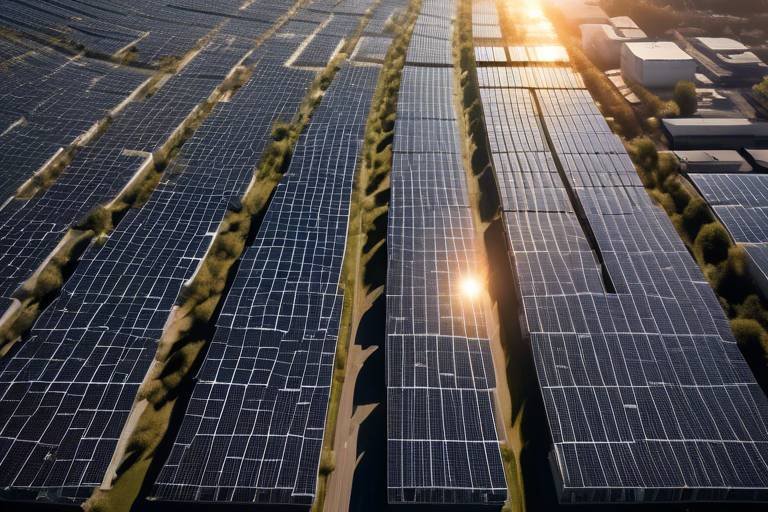Urban Agriculture: An Answer to City Food Security?
In a world where cities are expanding rapidly, the question of food security has become more pressing than ever. Urban agriculture emerges as a beacon of hope, offering innovative solutions to tackle the challenges of feeding urban populations. Imagine a city where fresh produce is not just a luxury but a staple accessible to everyone. This vision is becoming a reality as urban farms, community gardens, and rooftop plots spring up in unexpected places, transforming concrete jungles into green oases. Urban agriculture not only addresses food scarcity but also enhances the quality of life for city dwellers, creating vibrant communities centered around sustainable practices.
But what exactly is urban agriculture? It encompasses a wide range of practices, from growing vegetables on rooftops to maintaining community gardens in vacant lots. The beauty of urban agriculture lies in its adaptability; it can thrive in limited spaces while providing fresh, nutritious food. This practice is crucial for enhancing food security, especially in urban areas that often struggle with food deserts—regions where access to affordable, healthy food is limited. By integrating agriculture into urban planning, cities can become more resilient, reducing their dependency on external food sources and minimizing transportation costs.
Moreover, urban agriculture is not just about food—it’s about community. It fosters social connections among residents, encouraging collaboration and engagement. When people come together to cultivate a garden, they share not only the labor but also the rewards. This shared experience builds trust and strengthens community ties, which are essential for a thriving urban environment. Additionally, urban farms often become educational hubs, teaching residents about sustainable practices, nutrition, and environmental stewardship. Through hands-on experiences, individuals gain valuable skills that can empower them to make healthier choices and advocate for food justice.
However, urban agriculture is not without its challenges. Issues such as land access, zoning regulations, and funding can hinder the growth of these initiatives. Many aspiring urban farmers face obstacles in securing suitable land, often competing with real estate developers for prime locations. Furthermore, maintaining these spaces requires ongoing support and resources, which can be difficult to sustain in the long term. To truly realize the potential of urban agriculture, cities must prioritize policies that support these initiatives, ensuring that they are integrated into the urban landscape and accessible to all residents.
As we explore the various forms of urban agriculture, it becomes evident that each approach brings unique benefits and challenges. Whether it’s a community garden thriving in a neighborhood or a rooftop farm harnessing the sun’s energy, these initiatives contribute to a more sustainable and food-secure urban future. The journey toward urban food security is a collective effort, requiring collaboration among local governments, community organizations, and residents. Together, we can cultivate a greener, healthier future for our cities.
- What is urban agriculture? Urban agriculture refers to the practice of cultivating, processing, and distributing food in or around urban areas, utilizing available space to grow fresh produce.
- How does urban agriculture contribute to food security? It increases access to fresh food, reduces food deserts, and promotes local economies, enhancing the overall food system in cities.
- What are some common types of urban agriculture? Common types include community gardens, rooftop farms, and vertical farming, each with its own set of benefits and challenges.
- What challenges do urban farms face? Urban farms often struggle with land access, funding, maintenance, and navigating local regulations.
- How can I get involved in urban agriculture? You can participate by joining local community gardens, supporting urban farms, or even starting your own small garden at home!

The Importance of Urban Agriculture
Urban agriculture is not just a buzzword; it’s a game-changer for food security in cities. Imagine walking through your neighborhood and seeing vibrant gardens bursting with fresh vegetables and fruits. This isn’t just a dream; it’s a reality that many urban areas are starting to embrace. By integrating agriculture into urban settings, we can tackle several pressing issues that cities face today.
One of the most significant benefits of urban agriculture is its ability to provide fresh produce directly to city dwellers. In many urban areas, access to fresh food can be limited, leading to what are known as food deserts. These are neighborhoods where residents have little to no access to affordable and nutritious food. Urban agriculture can bridge this gap, making fresh fruits and vegetables available right in the community, thereby promoting healthier eating habits.
Additionally, urban agriculture plays a vital role in reducing the carbon footprint associated with transporting food. When food is grown locally, it doesn’t have to travel long distances to reach consumers, which means fewer emissions from vehicles. This not only benefits the environment but also enhances the local economy by keeping money within the community.
Moreover, urban agriculture fosters community engagement. It brings people together, allowing them to work side by side in gardens and farms. This interaction can lead to stronger community ties and a sense of belonging. When residents collaborate to grow food, they often share knowledge, skills, and resources, creating a support network that can enhance overall community resilience.
Another important aspect is the environmental sustainability that urban agriculture promotes. By incorporating green spaces into urban planning, cities can improve air quality, reduce urban heat, and enhance biodiversity. For instance, community gardens can serve as habitats for various species, helping to restore the ecological balance in urban settings.
In summary, urban agriculture is crucial for enhancing food security in cities. It provides fresh produce, reduces food deserts, boosts local economies, promotes community engagement, and supports environmental sustainability. As cities continue to grow, integrating agriculture into urban life will be essential for creating a healthier, more sustainable future.
- What is urban agriculture? Urban agriculture refers to the practice of cultivating, processing, and distributing food in or around urban areas.
- How does urban agriculture improve food security? It provides direct access to fresh produce, reduces reliance on food transported from rural areas, and enhances community resilience.
- What are some examples of urban agriculture? Examples include community gardens, rooftop farms, and vertical farms.
- Can urban agriculture benefit the environment? Yes, it can improve air quality, reduce urban heat, and increase biodiversity.

Types of Urban Agriculture
Urban agriculture is not a one-size-fits-all solution; rather, it encompasses a variety of practices that cater to different needs and environments within the city. Each type of urban agriculture brings its own flavor to the table, contributing uniquely to the urban food landscape. The most common forms include community gardens, rooftop farms, and vertical farming. These methods not only help in producing food but also foster community spirit and sustainability.
To dive deeper, let's explore each type:
Community gardens are like little green oases amidst the concrete jungle. They allow residents to come together, cultivate the land, and grow their own food. These gardens are more than just patches of soil; they are vibrant spaces that promote social interaction and community bonding. Imagine a group of neighbors, once strangers, now united by a shared passion for gardening! Together, they enhance local biodiversity and create educational opportunities for everyone involved.
The benefits of community gardens are manifold. They provide fresh produce right at your doorstep, which is especially vital in areas that might be classified as food deserts. Beyond nutrition, these gardens can significantly improve mental health by offering a peaceful retreat and a sense of accomplishment. Furthermore, they serve as platforms for environmental education, teaching participants about sustainable practices and healthy eating habits.
However, it’s not all sunshine and daisies. Community gardens face several hurdles that can hinder their growth and sustainability. Issues like land access, funding, and maintenance can pose significant challenges. For instance, securing land in urban areas can be a daunting task due to rising property prices. Additionally, consistent funding is crucial to maintain these gardens and keep them thriving. Addressing these challenges is essential to ensure that community gardens continue to flourish and contribute positively to urban food security.
Now, let’s look up—literally! Rooftop farming takes advantage of the often-overlooked spaces atop buildings. By transforming these underutilized areas into productive farms, urban dwellers can grow a variety of crops while contributing to a greener city. Imagine harvesting fresh herbs or vegetables just a flight of stairs away! Rooftop farms not only supply fresh produce but also help mitigate the urban heat island effect and improve air quality. They create a unique blend of agriculture and architecture, showcasing how innovation can lead to sustainable living.
Vertical farming is the cutting-edge approach that involves growing crops in stacked layers, often utilizing hydroponics or aeroponics. This method is revolutionary, as it allows for a significant increase in yield per square foot, making it an efficient way to produce food in densely populated areas. With the world’s population continuing to rise, vertical farming presents a viable solution to meet the growing demand for food while minimizing resource use.
The advancements in technology have transformed vertical farming into a highly efficient operation. Innovations in lighting, climate control, and automation play a crucial role in optimizing growth conditions. For instance, LED lighting systems can be tailored to provide the exact wavelengths needed for plant growth, while automated systems can monitor and adjust conditions in real-time. This not only boosts productivity but also reduces operational costs, making vertical farming a promising avenue for urban agriculture.
One of the standout features of vertical farming is its lower environmental footprint compared to traditional agriculture. It reduces the need for extensive land use, minimizes reliance on pesticides, and can even utilize renewable energy sources. This contributes to a more sustainable urban food system, ensuring that we can produce food without compromising the health of our planet. In a world where environmental concerns are paramount, vertical farming stands as a beacon of hope for sustainable urban living.
- What is urban agriculture?
Urban agriculture refers to the practice of cultivating, processing, and distributing food in or around urban areas, utilizing available space to grow food locally. - How does urban agriculture improve food security?
By providing fresh produce, reducing food deserts, and promoting local economies, urban agriculture enhances access to nutritious food in cities. - What are the main types of urban agriculture?
Common types include community gardens, rooftop farming, and vertical farming, each offering unique benefits and challenges. - What challenges do community gardens face?
Challenges include land access, funding, and maintenance, which can hinder their sustainability and impact on food security.

Community Gardens
Community gardens are more than just patches of green in bustling urban environments; they are vibrant spaces where neighbors come together to cultivate not only plants but also relationships. Imagine walking through a community garden on a sunny day, surrounded by the rich aroma of herbs and the vibrant colors of fresh vegetables. These gardens serve as a sanctuary for city dwellers, offering a respite from the concrete jungle while providing a source of fresh produce. They transform vacant lots into productive spaces, allowing communities to reclaim their environment and promote food sovereignty.
One of the most significant advantages of community gardens is their ability to foster social interaction. They create a sense of belonging and community pride, as residents work side by side to grow food. It's common to see families, children, and seniors all participating in gardening activities, sharing tips, and exchanging recipes. This interaction not only strengthens community ties but also promotes cultural exchange, as different gardening techniques and culinary traditions come together. Additionally, community gardens often become hubs for educational opportunities, where local organizations and volunteers teach sustainable gardening practices, healthy eating, and environmental stewardship.
However, it's essential to recognize that community gardens don't come without their challenges. Issues such as land access, funding, and maintenance can hinder their establishment and sustainability. In many cities, securing land for gardening can be a daunting task, especially in areas where real estate prices are soaring. Furthermore, ongoing funding is often required to cover costs related to tools, seeds, and water supply. Maintenance is another critical factor; without committed volunteers, gardens can quickly become overgrown and neglected. Addressing these challenges is crucial for ensuring that community gardens thrive and continue to contribute to urban food security.
In conclusion, community gardens represent a powerful tool for enhancing food security in urban areas. They not only provide fresh produce but also cultivate community spirit and environmental awareness. As cities continue to grow and face challenges related to food access, the role of community gardens will only become more vital. By investing in these green spaces, we can help create healthier, more resilient urban communities.
- What is a community garden? A community garden is a shared space where individuals come together to grow fruits, vegetables, and flowers, fostering community bonds.
- How can I start a community garden? To start a community garden, gather interested neighbors, find a suitable piece of land, and seek necessary permissions. Form a plan for garden layout and maintenance.
- What are the benefits of community gardens? Community gardens provide access to fresh produce, enhance mental well-being, promote social interaction, and educate participants about sustainable practices.
- What challenges do community gardens face? Common challenges include securing land, obtaining funding, and ensuring ongoing maintenance and volunteer participation.

Benefits of Community Gardens
Community gardens are more than just patches of green in urban landscapes; they are vibrant hubs of activity and connection. One of the most significant benefits of these gardens is their ability to improve mental health. Imagine stepping into a lush garden after a long day; the sights and smells of fresh herbs and blooming flowers can instantly uplift your mood. Studies suggest that gardening can reduce stress, anxiety, and even symptoms of depression. It's like therapy, but instead of a couch, you have a trowel!
Another key advantage is the increased access to fresh produce. In many cities, especially those labeled as food deserts, residents often struggle to find affordable and nutritious food. Community gardens directly address this issue by providing fresh fruits and vegetables right in the neighborhood. This not only enhances dietary options but also encourages healthier eating habits. Plus, nothing beats the taste of a homegrown tomato!
Furthermore, community gardens foster strong social ties among residents. When people come together to cultivate a shared space, they develop friendships and a sense of belonging. This communal spirit can lead to a more cohesive neighborhood where residents look out for one another. In essence, these gardens can transform strangers into friends, nurturing a sense of community that is often lacking in urban settings.
In addition to social benefits, community gardens also serve as platforms for environmental education. They provide opportunities for residents, especially children, to learn about sustainable practices, biodiversity, and the importance of local food systems. Workshops and gardening classes can be organized, fostering a culture of sustainability and awareness. It's like having a classroom under the open sky!
However, it’s essential to recognize that the benefits of community gardens extend beyond individual and communal advantages. They also contribute positively to the environment. By increasing green spaces, these gardens help improve urban air quality, reduce the urban heat island effect, and promote biodiversity by providing habitats for various species. In a world increasingly affected by climate change, every little bit helps!
In summary, community gardens are multifaceted resources that enhance mental health, improve access to fresh produce, strengthen community ties, and promote environmental education. They are a testament to the idea that when people come together to cultivate the land, they can cultivate a better quality of life for everyone involved.
- What is a community garden?
A community garden is a shared space where individuals can grow food together, fostering community interaction and engagement.
- How can I start a community garden in my neighborhood?
Starting a community garden involves gathering interested participants, finding a suitable piece of land, and organizing resources and funding for maintenance.
- What are the environmental benefits of community gardens?
Community gardens improve air quality, reduce urban heat, and promote biodiversity, contributing to a healthier urban ecosystem.
- Can community gardens help with food insecurity?
Yes, by providing fresh produce in neighborhoods with limited access to healthy food, community gardens play a crucial role in addressing food insecurity.

Challenges of Community Gardens
While community gardens offer a plethora of benefits, they are not without their challenges. One of the most significant hurdles is land access. In densely populated urban areas, finding suitable land for gardening can feel like searching for a needle in a haystack. Many communities face the reality of vacant lots being owned by private entities or the government, leading to a complex web of regulations and permissions that can stall garden initiatives. Furthermore, the issue of funding cannot be overlooked. Establishing and maintaining a community garden often requires financial resources for tools, seeds, soil, and water. Without proper funding, many gardens struggle to thrive, leading to disillusionment among community members.
Another challenge is maintenance. Community gardens require regular care and attention, which can be difficult to manage when volunteers have varying schedules. The lack of consistent participation can result in overgrown plots, pest infestations, or even abandonment of the garden altogether. This inconsistency not only affects the garden's productivity but can also diminish community spirit, as members may feel frustrated by the lack of progress. Additionally, education and knowledge about sustainable gardening practices are essential. Many community members may come from diverse backgrounds with varying levels of gardening experience, leading to potential conflicts or misunderstandings about how to manage the garden effectively.
Lastly, the environmental factors can pose challenges as well. Urban areas often have poor soil quality, pollution, and limited sunlight, which can hinder plant growth. Gardeners may need to invest in soil testing and amendments, or even consider raised beds, which can complicate matters further. Despite these challenges, community gardens remain a beacon of hope for urban food security, fostering resilience and creativity as communities work together to overcome obstacles.
| Challenge | Description |
|---|---|
| Land Access | Difficulty in finding suitable land due to ownership and regulations. |
| Funding | Need for financial resources to cover tools, seeds, and maintenance costs. |
| Maintenance | Challenges in consistent care from volunteers, leading to neglect. |
| Education | Varying levels of gardening knowledge among community members. |
| Environmental Factors | Poor soil quality and urban pollution affecting plant growth. |
- What are community gardens? Community gardens are shared spaces where individuals come together to grow food, share resources, and build community.
- How can I start a community garden? Start by gathering interested individuals, securing land, and forming a plan for what to grow and how to maintain the garden.
- What are the benefits of community gardens? They provide fresh produce, enhance community ties, and promote environmental sustainability.
- What challenges do community gardens face? Common challenges include land access, funding, maintenance, and environmental factors.

Rooftop Farming
Rooftop farming is an innovative approach that transforms the often-overlooked spaces atop buildings into vibrant green landscapes filled with crops. Imagine looking out your window and seeing a lush garden instead of just concrete or asphalt. This method not only maximizes space in densely populated urban areas but also provides a plethora of benefits that contribute to the overall health of a city. By utilizing these underused areas, we can grow fresh produce right where it’s needed, reducing the need for long transportation routes and lowering carbon emissions.
One of the most significant advantages of rooftop farming is its ability to help mitigate the urban heat island effect. Cities are notorious for being hotter than their rural counterparts due to the abundance of concrete and asphalt. Rooftop gardens act as natural air conditioners, cooling the surrounding air and making the urban environment more pleasant. Furthermore, they improve air quality by filtering pollutants and releasing oxygen, creating a healthier atmosphere for city dwellers.
But the benefits don’t stop there! Rooftop farms can also serve as educational spaces where communities can learn about sustainable practices and the importance of local food systems. Schools and organizations often partner with rooftop farms to provide hands-on learning experiences, helping to cultivate a new generation of environmentally conscious individuals. These farms can also foster community engagement, bringing neighbors together to share the joys of gardening and the rewards of fresh food.
However, rooftop farming does come with its own set of challenges. The structural integrity of buildings must be considered before embarking on such projects. Not every roof is suitable for farming; some may not have the capacity to support the weight of soil, plants, and water. Additionally, access to water and sunlight can be limited, which may require innovative solutions like drip irrigation systems or the use of reflective materials to enhance light exposure.
To put it simply, rooftop farming is more than just a trend; it’s a necessary step towards creating sustainable urban environments. As cities continue to grow, integrating agriculture into our living spaces will be crucial in addressing food security challenges. By turning rooftops into farms, we can cultivate not only food but also community spirit and environmental awareness.
- What types of crops can be grown on rooftops? Rooftop farms can grow a variety of crops including herbs, leafy greens, tomatoes, and even some root vegetables, depending on the growing conditions.
- Do rooftop farms require special equipment? Yes, rooftop farms often utilize specialized equipment such as lightweight soil, irrigation systems, and sometimes hydroponic setups to optimize growth.
- How do rooftop farms contribute to biodiversity? They create green spaces that attract pollinators and other wildlife, helping to enhance urban biodiversity.
- Can anyone start a rooftop farm? While anyone can start a rooftop farm, it’s important to assess the building’s structure and local regulations regarding rooftop gardening.

Vertical Farming
Vertical farming is a groundbreaking approach to agriculture that takes advantage of urban space by growing crops in stacked layers. Imagine a skyscraper, but instead of offices, it’s filled with lush greenery and vibrant vegetables. This innovative method not only maximizes the use of limited urban land but also significantly boosts the yield of crops per square foot. With the world’s population projected to reach nearly 10 billion by 2050, the demand for food is skyrocketing. Vertical farming presents a sustainable solution to meet this challenge while minimizing the environmental impact of traditional farming practices.
One of the standout features of vertical farming is its ability to employ advanced technologies, such as hydroponics and aeroponics, which allow plants to grow without soil. These systems use nutrient-rich water or mist to nourish the plants, leading to faster growth rates and higher yields. In fact, studies have shown that vertical farms can produce up to 10 times more food per square foot than conventional farms. This is particularly essential in urban areas where space is at a premium.
Moreover, vertical farms are designed to be energy-efficient and sustainable. They often utilize renewable energy sources, such as solar or wind power, which can drastically reduce their carbon footprint. In addition, many vertical farms implement closed-loop systems that recycle water and nutrients, further minimizing waste. This not only helps in conserving precious resources but also contributes to creating a more resilient urban food system.
| Advantages of Vertical Farming | Challenges of Vertical Farming |
|---|---|
| Maximizes space in urban settings | High initial setup costs |
| Reduces the need for pesticides | Requires advanced technology and skilled labor |
| Year-round crop production | Dependence on energy sources |
| Lower transportation costs and emissions | Market acceptance and consumer awareness |
As the technology behind vertical farming continues to evolve, we can expect to see even more innovative solutions that enhance productivity and sustainability. For instance, advancements in LED lighting technology have allowed farms to optimize light conditions for various crops, significantly improving growth rates while reducing energy consumption. Similarly, climate control systems can create the perfect environment for plants to thrive, regardless of external weather conditions.
However, it's essential to recognize that vertical farming is not without its challenges. The initial investment required to set up a vertical farm can be substantial, and the reliance on technology means that skilled labor is necessary to operate these systems efficiently. Additionally, while vertical farming can reduce transportation emissions by producing food closer to consumers, it still faces hurdles in market acceptance and consumer awareness. Educating the public about the benefits of vertically farmed produce is crucial for its success.
In conclusion, vertical farming is a promising solution to the pressing issues of food security and sustainability in urban areas. By integrating cutting-edge technology with innovative agricultural practices, we can transform our cities into green, food-producing hubs. As more urban areas embrace this approach, the potential for vertical farming to revolutionize the way we grow food in cities is truly exciting.
- What is vertical farming? Vertical farming is a method of growing crops in stacked layers, often utilizing hydroponics or aeroponics, in controlled environments.
- What are the benefits of vertical farming? It maximizes space, reduces pesticide use, allows for year-round production, and lowers transportation costs.
- What challenges does vertical farming face? High initial setup costs, reliance on technology, and the need for skilled labor are some of the challenges.
- Is vertical farming sustainable? Yes, it often utilizes renewable energy and closed-loop systems to minimize waste and environmental impact.

Technological Innovations in Vertical Farming
Vertical farming has been transformed by a wave of technological innovations that are revolutionizing how we grow food in urban environments. Imagine a world where fresh produce is grown within the confines of skyscrapers, utilizing cutting-edge technology to maximize efficiency and sustainability. This is not just a dream; it’s becoming a reality thanks to advancements in various fields.
One of the most significant innovations is the use of LED lighting. Traditional agriculture relies heavily on sunlight, but vertical farms can simulate natural light conditions using energy-efficient LEDs. These lights can be tuned to specific wavelengths that optimize plant growth, leading to higher yields and faster growth cycles. This means that urban farmers can produce more food in less time, making fresh produce readily available for city dwellers.
Another game-changer is the incorporation of climate control systems. By utilizing sensors and automation, vertical farms can maintain optimal growing conditions year-round. This technology allows farmers to adjust temperature, humidity, and even CO2 levels to create the perfect environment for crops. Imagine walking into a vertical farm where the air feels just right, and the plants are thriving—this is made possible by advanced climate control technologies.
Furthermore, hydroponics and aeroponics are at the forefront of vertical farming techniques. Hydroponics uses nutrient-rich water to grow plants without soil, while aeroponics takes it a step further by misting the roots with nutrients. These methods not only use less water than traditional farming but also eliminate the need for pesticides and herbicides, leading to cleaner and healthier produce. The ability to grow crops in stacked layers allows for a significant increase in yield per square foot, making it an efficient solution for urban food production.
To illustrate the impact of these technologies, consider the following table that compares traditional farming with vertical farming:
| Aspect | Traditional Farming | Vertical Farming |
|---|---|---|
| Space Utilization | Requires large land areas | Maximizes space through stacking |
| Water Usage | High water consumption | Uses up to 90% less water |
| Pesticide Use | Heavy reliance on chemicals | Minimal to no pesticide use |
| Yield | Variable yield based on season | Consistent high yield year-round |
As we look towards the future, the integration of artificial intelligence (AI) and machine learning is poised to take vertical farming to new heights. These technologies can analyze vast amounts of data to predict plant growth patterns, optimize resource usage, and even manage pest control more effectively. Imagine a system that learns from each crop cycle and adjusts parameters to ensure the best possible yield—this is the promise of AI in vertical farming.
In conclusion, the technological innovations in vertical farming are not just enhancing productivity; they are paving the way for a more sustainable and efficient food system in urban areas. As cities continue to grow, embracing these technologies will be crucial in addressing food security challenges and ensuring that everyone has access to fresh, healthy produce.
- What is vertical farming? Vertical farming is an innovative agricultural practice that involves growing crops in stacked layers, often using hydroponic or aeroponic systems, to maximize space and efficiency.
- How does vertical farming contribute to food security? By producing food within urban areas, vertical farming reduces transportation costs and provides fresh produce to city residents, thereby enhancing food security.
- What are the environmental benefits of vertical farming? Vertical farming uses significantly less water, reduces pesticide reliance, and can utilize renewable energy sources, contributing to a more sustainable food system.
- Can vertical farming be done on a small scale? Yes, vertical farming can be adapted for small spaces, making it accessible for individuals and communities interested in growing their own food.

Environmental Impact of Vertical Farming
This article explores the role of urban agriculture in enhancing food security in cities, discussing its benefits, challenges, and the various approaches being adopted around the world to integrate agriculture into urban settings.
Urban agriculture plays a crucial role in food security by providing fresh produce, reducing food deserts, and promoting local economies. It also fosters community engagement and environmental sustainability within urban areas.
Various forms of urban agriculture exist, including community gardens, rooftop farms, and vertical farming. Each type has unique benefits and challenges, contributing differently to urban food systems and community well-being.
Community gardens serve as communal spaces where residents can grow food together. They promote social interaction, enhance biodiversity, and provide educational opportunities about sustainable practices and healthy eating.
Community gardens offer numerous benefits, such as improved mental health, increased access to fresh produce, and strengthened community ties. They can also serve as platforms for environmental education and activism.
Despite their advantages, community gardens face challenges such as land access, funding, and maintenance. Addressing these issues is essential for their sustainability and overall impact on food security.
Rooftop farming utilizes underused urban spaces to grow crops, providing fresh produce while reducing urban heat and improving air quality. This innovative approach maximizes space and integrates agriculture into the urban landscape.
Vertical farming employs innovative techniques to grow crops in stacked layers, often using hydroponics or aeroponics. This method can significantly increase yield per square foot while minimizing resource use and transportation costs.
Technological advancements have revolutionized vertical farming, enabling efficient resource management and higher productivity. Innovations in lighting, climate control, and automation are essential for optimizing growth conditions and reducing costs.
Vertical farming has emerged as a game-changer in the quest for sustainable food production in urban environments. By utilizing stacked layers to maximize space, this method not only increases yield but also significantly reduces the environmental footprint associated with traditional agriculture. One of the most compelling aspects of vertical farming is its ability to minimize land use. In a world where urban sprawl is consuming fertile land at an alarming rate, vertical farms can be established in abandoned buildings, warehouses, or even on rooftops, thereby preserving valuable green spaces.
Moreover, vertical farming drastically cuts down on the need for pesticides and herbicides. The controlled environments in which these farms operate can effectively eliminate pests without the need for harmful chemicals, promoting healthier produce for consumers. This method also allows for the use of renewable energy sources. Many vertical farms are now integrating solar panels and wind turbines, further decreasing their carbon footprints. The potential for water conservation in vertical farming is another significant benefit. Traditional agriculture is notorious for its high water consumption, but vertical farms can use up to 90% less water through advanced hydroponic and aeroponic systems, where water is recirculated and reused.
To illustrate the environmental benefits of vertical farming, consider the following table:
| Environmental Impact | Traditional Agriculture | Vertical Farming |
|---|---|---|
| Land Use | High | Low |
| Pesticide Use | High | Minimal |
| Water Usage | High | Up to 90% less |
| Carbon Footprint | High | Lower |
In conclusion, as cities continue to grow and the demand for food increases, vertical farming offers a sustainable solution that addresses both environmental concerns and food security. By integrating advanced technologies and innovative practices, vertical farming not only meets the needs of urban populations but also contributes to a healthier planet.
- What is vertical farming? Vertical farming is the practice of growing crops in stacked layers, often using controlled-environment agriculture techniques.
- How does vertical farming benefit the environment? It reduces land use, minimizes pesticide reliance, conserves water, and can utilize renewable energy sources.
- Can vertical farming be implemented in any urban area? Yes, vertical farms can be set up in various urban locations, including rooftops and abandoned buildings.
- Is vertical farming cost-effective? While initial setup costs can be high, the long-term savings in water, land, and transportation can make it economically viable.
Frequently Asked Questions
- What is urban agriculture?
Urban agriculture refers to the practice of cultivating, processing, and distributing food in or around urban areas. It includes various methods such as community gardens, rooftop farms, and vertical farming, all aimed at enhancing food security and sustainability in cities.
- How does urban agriculture contribute to food security?
Urban agriculture plays a vital role in food security by providing fresh produce directly to urban residents, reducing reliance on distant food sources. It helps eliminate food deserts, promotes local economies, and encourages community engagement, making cities more resilient to food supply disruptions.
- What are the benefits of community gardens?
Community gardens offer numerous advantages, including improved mental health, enhanced access to fresh fruits and vegetables, and stronger community ties. They also serve as educational platforms for sustainable practices and healthy eating, fostering social interaction among residents.
- What challenges do community gardens face?
Despite their many benefits, community gardens often struggle with issues such as land access, funding, and ongoing maintenance. Addressing these challenges is crucial for their sustainability and effectiveness in improving urban food security.
- What is rooftop farming and its benefits?
Rooftop farming utilizes unused urban spaces, like rooftops, to grow crops. This innovative approach not only provides fresh produce but also helps reduce urban heat, improves air quality, and maximizes space in densely populated areas.
- How does vertical farming work?
Vertical farming involves growing crops in stacked layers, often using techniques like hydroponics or aeroponics. This method significantly increases yield per square foot while minimizing resource use, making it an efficient solution for urban food production.
- What technological innovations are used in vertical farming?
Advancements in technology have greatly enhanced vertical farming. Innovations in lighting, climate control, and automation help optimize growth conditions, improve productivity, and reduce costs, making it a more viable option for urban agriculture.
- What is the environmental impact of vertical farming?
Vertical farming has a lower environmental footprint compared to traditional agriculture. It reduces land use, minimizes pesticide reliance, and can utilize renewable energy sources, contributing to a more sustainable urban food system.



















